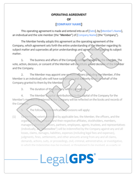How to Handle LLC Debts When Exiting
Exiting an LLC isn’t just about selling your business or dissolving the entity—it’s also about handling any outstanding debts responsibly. Unpaid...
8 min read
LegalGPS : Sep. 16, 2025
When Sarah Martinez decided to exit her 40% stake in a thriving digital marketing LLC, she thought the hardest part would be valuing her ownership interest. She was wrong. The real challenge came when she discovered the company owed $180,000 across multiple creditors, and the remaining partners wanted her to remain personally liable for her share of the debt.


Legal GPS Pro
Protect your business with our complete legal subscription service, designed by top startup attorneys.
Sarah's situation illustrates a critical reality that many LLC members face during exits: debt settlement can make or break your transition strategy. Whether you're selling your interest, withdrawing from the company, or facilitating a complete business sale, how you handle existing debts determines whether you walk away clean or remain entangled in financial obligations for years to come.
The complexity of LLC debt settlement has only increased in 2025, with new regulations affecting everything from PPP loan obligations to revised personal guarantee enforcement. Understanding your options and implementing the right strategies protects both your financial future and your business relationships.
LLC debt extends far beyond traditional bank loans and credit lines. During an exit, you must account for accounts payable, accrued expenses, tax obligations, lease commitments, and any contingent liabilities that could surface later. Equipment financing, vendor agreements with personal guarantees, and even disputed contractor payments can complicate your departure.
The distinction between recourse and non-recourse debt becomes crucial during exits. Recourse debt allows creditors to pursue personal assets of LLC members, while non-recourse debt limits creditor claims to business assets only. Most small business debts include personal guarantees, making them recourse obligations that follow departing members unless properly addressed.

Debt Settlement Agreement for LLC Exit
When a member leaves the LLC with outstanding obligations a Debt Settlement Agreement helps resolve financial issues cleanly. It is a must-have for wrapping things up without conflict.
Trusted by 1,000+ businesses to safeguard their LLCs.
State LLC laws vary significantly in how they handle member departures and debt obligations. Most jurisdictions require departing members to provide adequate notice and allow the LLC time to pay or settle outstanding obligations before releasing the member from liability.
The key legal principle governing LLC debt settlements is the concept of "charging order protection." This protection shields your personal assets from business creditors, but only if you properly structure your exit and avoid actions that could be deemed fraudulent transfers or preferential payments to members.
Before initiating any exit discussions, compile a complete debt inventory that includes principal balances, interest rates, payment terms, personal guarantee requirements, and maturity dates. Request current statements from all creditors and review loan agreements for acceleration clauses that might be triggered by ownership changes.
Don't overlook contingent liabilities such as pending lawsuits, warranty obligations, or regulatory compliance issues that could generate future costs. These hidden debts often surface during due diligence processes and can derail otherwise smooth exit negotiations.
Rank debts by urgency and negotiability to focus your settlement efforts effectively. Place secured debts with personal guarantees at the top priority, followed by tax obligations and critical vendor relationships. This matrix helps you allocate limited settlement resources where they'll have the most impact on your clean exit.
Consider each creditor's relationship importance to ongoing business operations. Settling with a one-time supplier may be straightforward, while negotiating with your primary bank requires more strategic thinking about the company's future financing needs.
When withdrawing from an LLC while the business continues operating, your settlement strategy should focus on transferring debt responsibility to remaining members or the company itself. The most effective approach involves negotiating a comprehensive release agreement that includes specific debt assumption language.
Work with remaining members to restructure personal guarantees, removing your name from future obligations while potentially remaining liable for a defined period on existing debts. This transition period gives the business time to establish independent creditworthiness while protecting creditor interests.
Complete business sales offer the cleanest debt settlement opportunities, as buyers typically assume all business obligations as part of the acquisition. However, personal guarantees don't automatically transfer to new owners, requiring explicit creditor consent and release documentation.
Structure the sale agreement to include debt payoff schedules and guarantee release timelines. Some creditors may require the selling members to remain liable for a transitional period, which affects both the sale price and your post-exit exposure.
When partners Jake Chen and Maria Rodriguez decided to sell their successful bistro, they discovered their $320,000 in combined debt included personal guarantees on equipment leases that the buyer couldn't assume due to credit restrictions. The equipment lessor refused to release the original guarantees without additional security.
The solution involved a three-party agreement where the buyer provided an additional $50,000 deposit held in escrow for 18 months, giving the lessor security while allowing Jake and Maria to complete their exit. The deposit was released when the buyer demonstrated consistent payment history, and the original partners were finally released from all obligations.
This case demonstrates how creative structuring can overcome creditor resistance while protecting all parties' interests.
Contact creditors early in your exit planning process, well before finalizing any agreements with co-members or potential buyers. Early communication demonstrates good faith and gives you more negotiating leverage than last-minute notifications that might trigger default provisions or accelerate payment demands.
Emphasize to creditors that your orderly exit supports business stability and their long-term payment prospects. Frame settlements as continuity plans rather than exit strategies, highlighting how remaining ownership will strengthen the company's ability to meet obligations.
Use this continuity argument to negotiate extended payment terms, reduced settlement amounts, or favorable release provisions that might not be available in distressed sale situations.
Present creditors with clear transition plans that show how their interests will be protected throughout your exit process. Most creditors prefer working with borrowers who communicate proactively rather than learning about ownership changes through third parties or missed payments.
When David Park decided to exit his construction LLC, the company owed $280,000 to suppliers and carried a $150,000 SBA loan with his personal guarantee. Rather than demanding immediate resolution, David negotiated a six-month transition plan with all creditors.
The agreement included monthly status updates, continued personal guarantee coverage during the transition, and a commitment that his 60% ownership interest would be purchased by remaining partners using proceeds from a refinancing that removed David from all future obligations.
This phased approach maintained vendor relationships, avoided triggering loan acceleration clauses, and gave David a clean exit without disrupting ongoing projects or cash flow.
Properly drafted debt assumption agreements transfer liability from exiting members to remaining parties while protecting creditor rights. These agreements must specify which debts are being assumed, effective dates for the transfer, and remedies available if assuming parties default on their obligations.
Include indemnification provisions that protect you from future claims related to assumed debts, and ensure assumption agreements are acknowledged by creditors to prevent disputes about enforceability.

Comprehensive release language protects exiting members from future liability exposure beyond the agreed settlement terms. The release should cover both known debts and potential future claims arising from pre-exit business activities.
Indemnification clauses shift responsibility for legal defense and damage payments to remaining members or acquiring parties. Structure these provisions with caps and time limits to prevent unlimited exposure while still providing meaningful protection.
When Lisa Thompson and Mark Williams sold their shares in a digital marketing agency, their operating agreement's standard withdrawal provisions left them exposed to ongoing vendor obligations and potential client disputes. Their attorney drafted supplemental agreements that included:
A comprehensive debt assumption schedule covering all 23 creditor relationships, specific release language for potential professional liability claims, and mutual indemnification provisions protecting both exiting and remaining partners from cross-claims.
The agreements also established a 24-month escrow fund to handle any disputed obligations that surfaced after the exit, providing security for all parties while enabling a clean transition.
Debt settlements often result in taxable income to the LLC or its members when creditors accept reduced payments or release obligations for less than full value. The amount of debt forgiveness generally constitutes cancellation of debt income, subject to regular income tax rates.
However, insolvency exceptions may apply if the LLC's liabilities exceed its assets at the time of settlement. Proper documentation of the company's financial condition becomes crucial for claiming these exceptions and minimizing tax consequences.
Structure debt settlements to occur in tax years when the LLC or departing members can best absorb the income impact. Consider spreading settlements across multiple tax years or coordinating with other deductions to minimize the overall tax burden.
Work with tax professionals to evaluate whether debt settlements should occur at the LLC level or through individual member negotiations, as the tax treatment may differ significantly depending on the structure chosen.
The most dangerous pitfall in LLC debt settlements involves assuming that business sales or member changes automatically release personal guarantees. Most guarantee agreements specifically state that guarantor liability continues despite ownership transfers unless creditors provide written releases.
Always obtain explicit guarantee releases as part of your exit documentation. If immediate releases aren't available, negotiate defined timelines and performance criteria that trigger automatic releases once new ownership demonstrates creditworthiness.
When Alex Rivera sold his software company to a larger competitor, he assumed the $200,000 line of credit would transfer with the business assets. The purchase agreement mentioned debt assumption, and Alex received his full sale proceeds without concern.
Eighteen months later, the acquiring company defaulted on the credit line after overextending on other acquisitions. The bank pursued Alex under his original personal guarantee, which had never been formally released. Alex faced full liability for the debt plus accumulated interest and legal fees.
This expensive lesson demonstrates why explicit creditor releases must be confirmed before considering any exit complete, regardless of how comprehensive other transaction documents may appear.
Informal settlement agreements or verbal understandings with creditors create dangerous enforcement gaps that can resurface years later. Always document debt settlement terms in writing, signed by all parties, with clear effective dates and performance requirements.
Include specific language about how settlement agreements interact with existing loan documents, operating agreements, and personal guarantees to prevent conflicting interpretations that could void your protections.
When your LLC owes money to multiple creditors with varying priority levels, personal guarantee requirements, and cross-default provisions, professional guidance becomes essential for navigating competing interests and legal requirements.
Attorney involvement pays for itself by preventing costly mistakes in guarantee releases, ensuring proper legal priority in settlement payments, and structuring agreements that withstand future challenges.
When partners in a metal fabrication company decided to dissolve their LLC, they faced $850,000 in debt across twelve creditors, including secured equipment loans, unsecured trade debt, and SBA obligations with varying personal guarantee requirements.
Their business attorney worked with a workout specialist to develop a comprehensive settlement plan that prioritized secured debt, negotiated reduced payments with unsecured creditors, and structured guarantee releases tied to specific performance milestones over 18 months.
The structured approach saved the partners over $200,000 in settlement costs compared to individual creditor negotiations, while ensuring all personal guarantee exposures were properly resolved through documented release agreements.
Professional coordination also prevented conflicting settlement terms that could have triggered cross-default provisions and complicated the entire dissolution process.
Successfully settling debts during an LLC exit requires careful planning, strategic negotiation, and proper documentation. The key lies in starting your debt assessment early, maintaining open communication with creditors, and ensuring that all settlement agreements provide comprehensive protection from future liability exposure.
Remember that debt settlement isn't just about paying what you owe – it's about structuring your departure to protect your financial future while maintaining business relationships and compliance with legal obligations. The strategies outlined here provide a framework for achieving clean exits that serve everyone's interests.
For LLC members planning exits in 2025, Legal GPS provides templates and resources specifically designed for debt settlement negotiations and exit documentation. Our Pro subscription includes access to attorney-drafted agreement templates that address the most common debt settlement scenarios, helping you avoid costly mistakes while protecting your interests throughout the exit process.
Don't let debt complications derail your exit strategy. With proper planning and the right agreements in place, you can achieve the clean departure you've worked hard to earn.

Legal GPS Pro
Protect your business with our complete legal subscription service, designed by top startup attorneys.
|
Premium Template
Single-use Template |
Legal GPS Pro
Unlimited Access, Best Value |
|
|
| Choose Template | Learn More |
| Trusted by 1000+ businesses | |
Table of Contents

Exiting an LLC isn’t just about selling your business or dissolving the entity—it’s also about handling any outstanding debts responsibly. Unpaid...

2 min read
When Mark's three-partner marketing agency faced an unexpected member departure in 2024, their hastily drafted operating agreement became their...

Dissolving an LLC isn't just about deciding you're done with business—it's a legal process that requires careful planning, proper documentation, and...